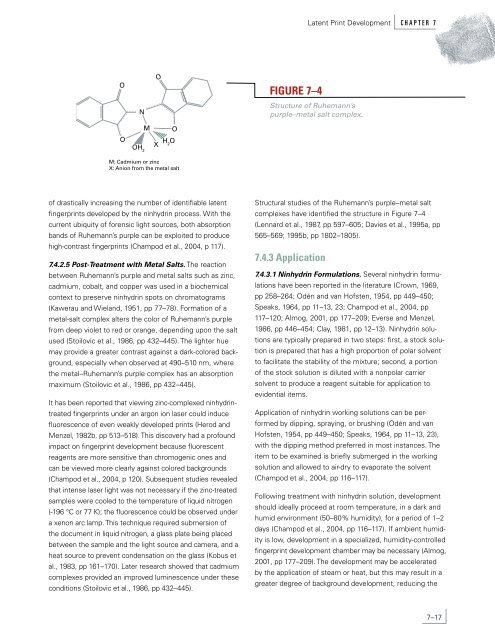Latent Print Development - National Criminal Justice Reference ...
Latent Print Development - National Criminal Justice Reference ...
Latent Print Development - National Criminal Justice Reference ...
Create successful ePaper yourself
Turn your PDF publications into a flip-book with our unique Google optimized e-Paper software.
O<br />
O<br />
- - - -<br />
- - - - - -- - - -<br />
of drastically increasing the number of identifiable latent<br />
fingerprints developed by the ninhydrin process. With the<br />
current ubiquity of forensic light sources, both absorption<br />
bands of Ruhemann’s purple can be exploited to produce<br />
high-contrast fingerprints (Champod et al., 2004, p 117).<br />
N<br />
OH 2<br />
7.4.2.5 Post-Treatment with Metal Salts. The reaction<br />
between Ruhemann’s purple and metal salts such as zinc,<br />
cadmium, cobalt, and copper was used in a biochemical<br />
context to preserve ninhydrin spots on chromatograms<br />
(Kawerau and Wieland, 1951, pp 77–78). Formation of a<br />
metal-salt complex alters the color of Ruhemann’s purple<br />
from deep violet to red or orange, depending upon the salt<br />
used (Stoilovic et al., 1986, pp 432–445). The lighter hue<br />
may provide a greater contrast against a dark-colored background,<br />
especially when observed at 490–510 nm, where<br />
the metal–Ruhemann’s purple complex has an absorption<br />
maximum (Stoilovic et al., 1986, pp 432–445).<br />
M<br />
It has been reported that viewing zinc-complexed ninhydrintreated<br />
fingerprints under an argon ion laser could induce<br />
fluorescence of even weakly developed prints (Herod and<br />
Menzel, 1982b, pp 513–518). This discovery had a profound<br />
impact on fingerprint development because fluorescent<br />
reagents are more sensitive than chromogenic ones and<br />
can be viewed more clearly against colored backgrounds<br />
(Champod et al., 2004, p 120). Subsequent studies revealed<br />
that intense laser light was not necessary if the zinc-treated<br />
samples were cooled to the temperature of liquid nitrogen<br />
(-196 °C or 77 K); the fluorescence could be observed under<br />
a xenon arc lamp. This technique required submersion of<br />
the document in liquid nitrogen, a glass plate being placed<br />
between the sample and the light source and camera, and a<br />
heat source to prevent condensation on the glass (Kobus et<br />
al., 1983, pp 161–170). Later research showed that cadmium<br />
complexes provided an improved luminescence under these<br />
conditions (Stoilovic et al., 1986, pp 432–445).<br />
X<br />
O<br />
- - - - - -<br />
- - - - - - - - -<br />
O<br />
H 2 O<br />
M: Cadmium or zinc<br />
X: Anion from the metal salt<br />
FIGURE 7–4<br />
Structure of Ruhemann’s<br />
purple–metal salt complex.<br />
Structural studies of the Ruhemann’s purple–metal salt<br />
complexes have identified the structure in Figure 7–4<br />
(Lennard et al., 1987, pp 597–605; Davies et al., 1995a, pp<br />
565–569; 1995b, pp 1802–1805).<br />
7.4.3 Application<br />
<strong>Latent</strong> <strong>Print</strong> <strong>Development</strong> C H A P T E R 7<br />
7.4.3.1 Ninhydrin Formulations. Several ninhydrin formulations<br />
have been reported in the literature (Crown, 1969,<br />
pp 258–264; Odén and van Hofsten, 1954, pp 449–450;<br />
Speaks, 1964, pp 11–13, 23; Champod et al., 2004, pp<br />
117–120; Almog, 2001, pp 177–209; Everse and Menzel,<br />
1986, pp 446–454; Clay, 1981, pp 12–13). Ninhydrin solutions<br />
are typically prepared in two steps: first, a stock solution<br />
is prepared that has a high proportion of polar solvent<br />
to facilitate the stability of the mixture; second, a portion<br />
of the stock solution is diluted with a nonpolar carrier<br />
solvent to produce a reagent suitable for application to<br />
evidential items.<br />
Application of ninhydrin working solutions can be performed<br />
by dipping, spraying, or brushing (Odén and van<br />
Hofsten, 1954, pp 449–450; Speaks, 1964, pp 11–13, 23),<br />
with the dipping method preferred in most instances. The<br />
item to be examined is briefly submerged in the working<br />
solution and allowed to air-dry to evaporate the solvent<br />
(Champod et al., 2004, pp 116–117).<br />
Following treatment with ninhydrin solution, development<br />
should ideally proceed at room temperature, in a dark and<br />
humid environment (50–80% humidity), for a period of 1–2<br />
days (Champod et al., 2004, pp 116–117). If ambient humidity<br />
is low, development in a specialized, humidity-controlled<br />
fingerprint development chamber may be necessary (Almog,<br />
2001, pp 177–209). The development may be accelerated<br />
by the application of steam or heat, but this may result in a<br />
greater degree of background development, reducing the<br />
7–17

















